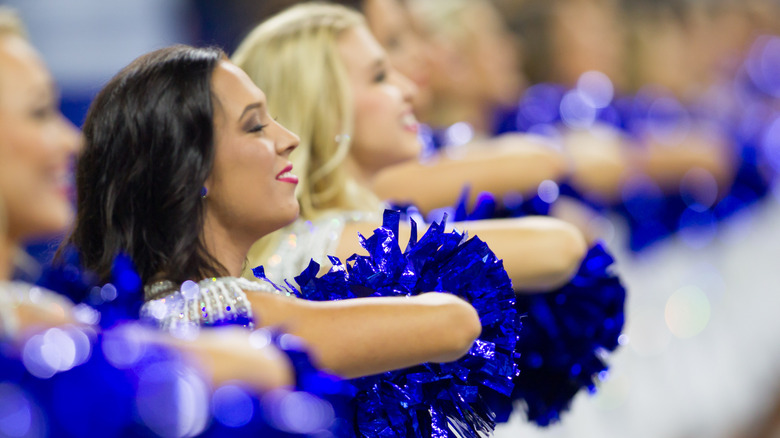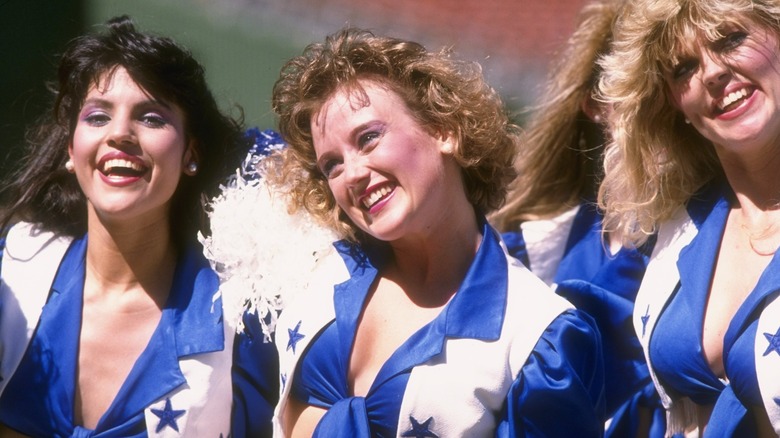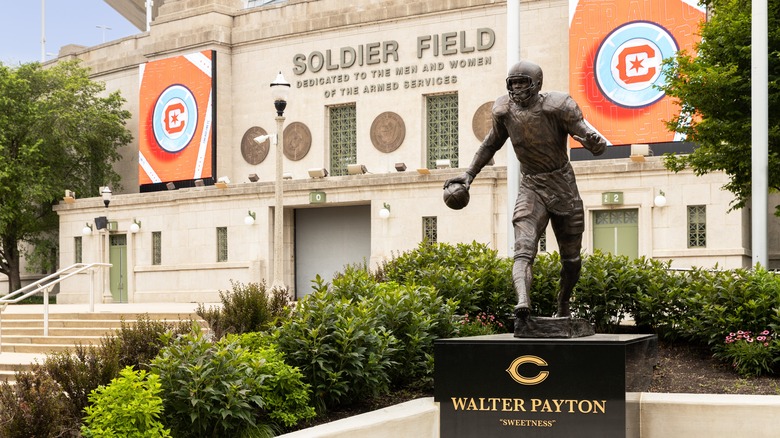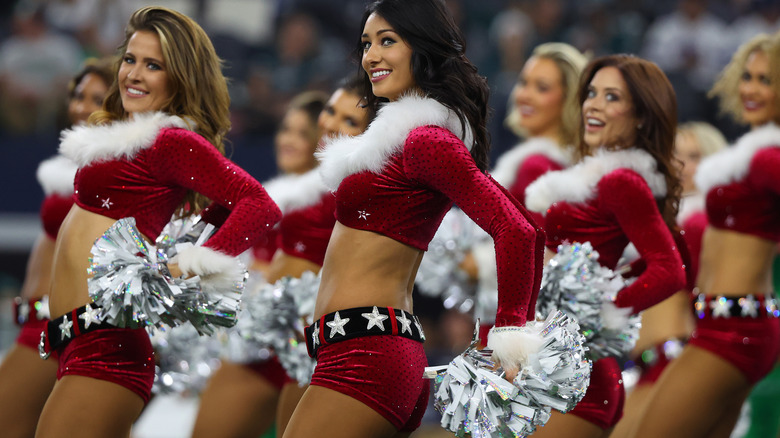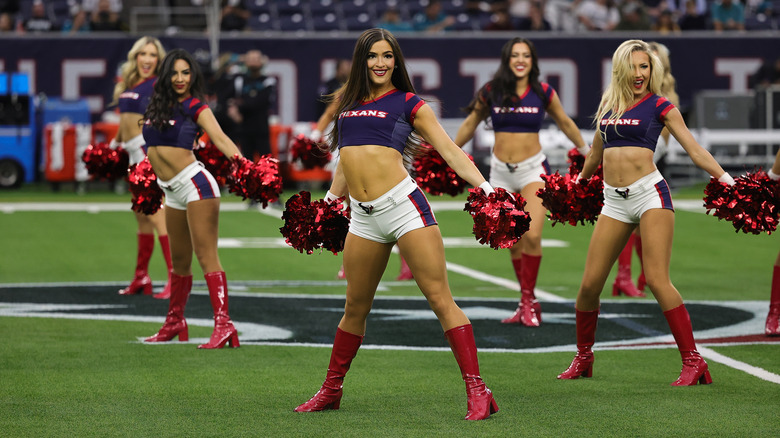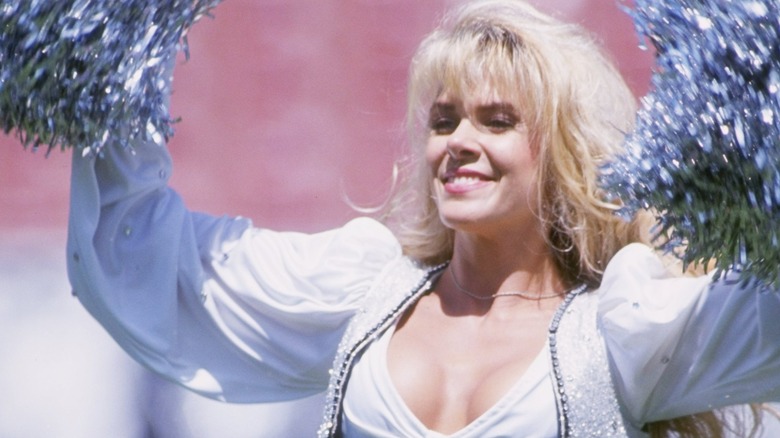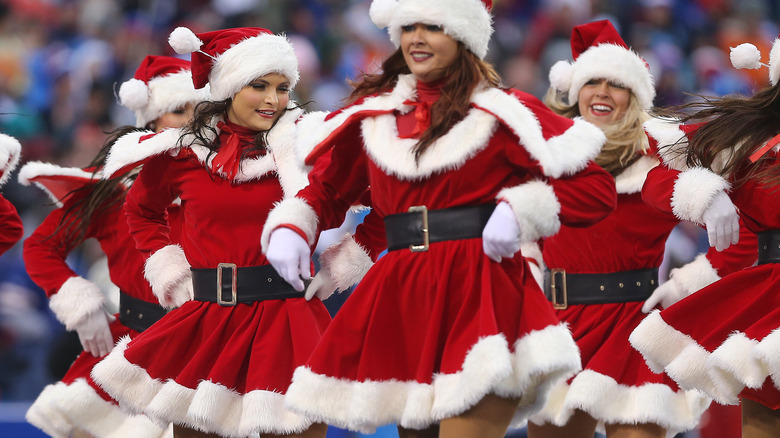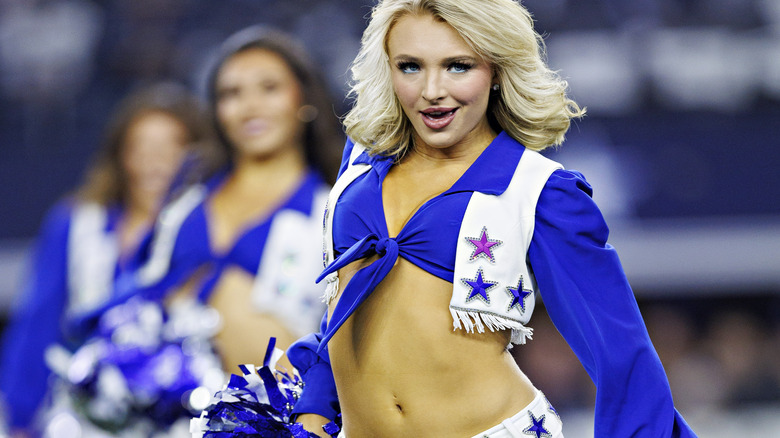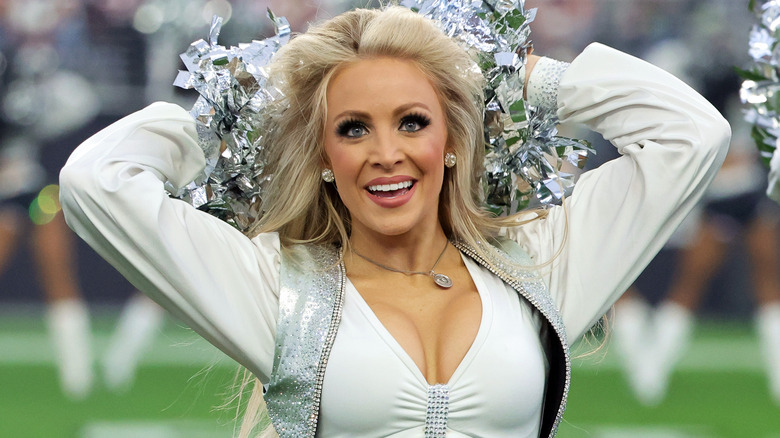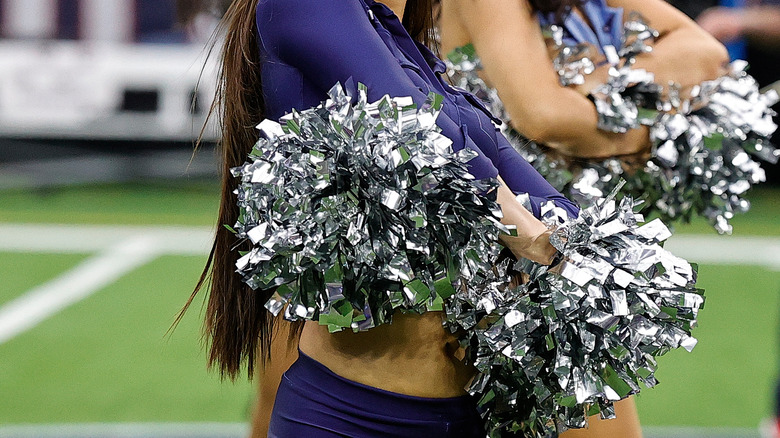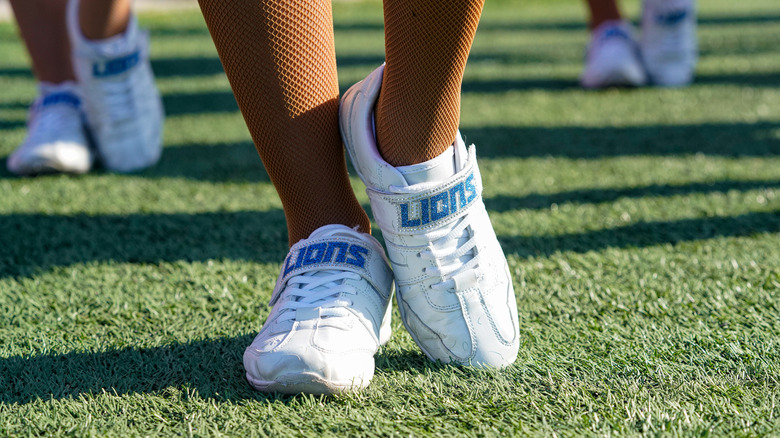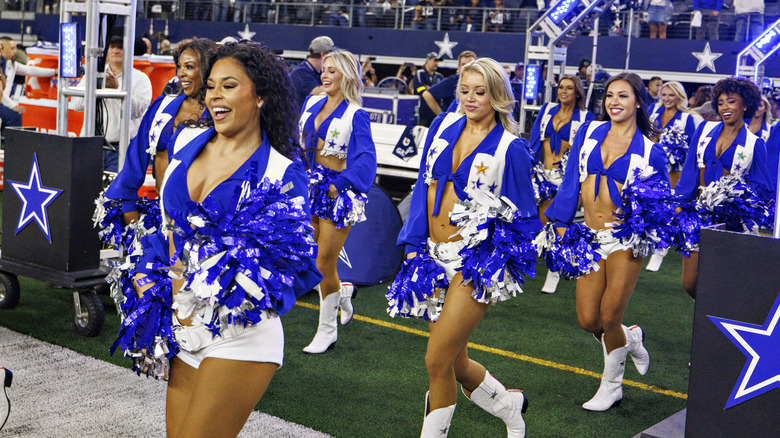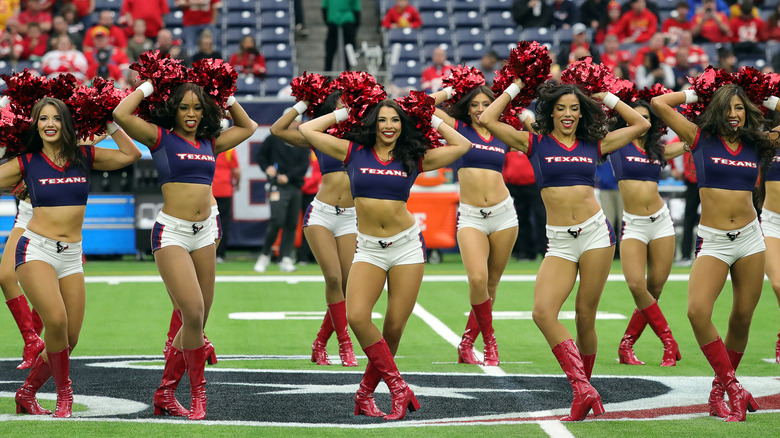The Dark History Of NFL Cheerleading
We may receive a commission on purchases made from links.
Scantily clad girls with pom-poms dancing on the sidelines of a football game are as American as apple pie ... which Mashed says is actually English, but that's a whole other story. While it might seem like they're having the best time of their lives cheering on their team's men, accusations and allegations made by NFL cheerleaders from multiple teams suggest that there's something incredibly dark going on behind the scenes.
Do enough digging, and it seems like it's been that way for a long time. Cheerleaders have all different reasons for trying out for an NFL team: Some might love the action and the interaction with the crowds; some might hope to launch a modeling or acting career; and for others, it might be a natural extension of a lifetime of dance. But according to what past and present NFL cheerleaders have said, the stress of making the team is nothing compared to the stress of staying on it ... and dealing with everything else that goes along with the uniform.
And it's awful stuff, including body-shaming, sexual harassment, abuse, long hours for little to no pay, eating disorders, and rampant misogyny. Hearing what cheerleaders have to say about their job suggests that those smiles are just for the cameras.
Cheerleading was overhauled to be drool-worthy
It's no secret that there are two kinds of outfits for NFL cheerleaders: skin-tight and nearly non-existent. It wasn't always that way, and when Vanity Fair did a deep dive into the history of NFL cheerleading, they found the origins — with the then-Baltimore Colts, now-Indianapolis Colts — were pretty modest. They wore sweaters, skirts, and saddle shoes, and when other NFL teams started their squads, it was with a similar look.
So, what happened? In a nutshell: The NFL realized that sex sells. When a burlesque performer walked through the stands during a 1967 Dallas game and the crowd went wild, the team's GM saw an opportunity and went for it. Tex Schramm knew the NFL was going through some major changes with the advent of the television age and decided to overhaul their previously modest cheerleaders into sex symbols with pom-poms. Stephanie Scholz was one of the early cheerleaders and explained that the squad was chosen so every male viewer would find his wildest fantasies fulfilled: "There was the long-haired blonde, the girl with the ponytail, the pigtail girl, the tall brunette, the perky little brunette, the bouncy blonde, the sultry redhead," she explained. And fans knew the names of their favorites.
Other teams followed in overhauling their cheerleaders, all in a play to boost their brand, image, and sponsorship deals. In Scholz's words, "It was a business, and we were the merchandise."
Complaints were always expected and dismissed
Cheerleaders, it seems, have always been expected to cater to the fans. Ultimate Cheerleaders spoke with former Chicago cheerleader Maribeth Duffy-Bolger, who recalled that while there were a lot of fun times, there were questionable ones, too. She referenced a game where the squad — called the Honey Bears — headed out on the field dressed in skirts instead of their usual, underwear-like bottoms. They were booed so badly and heckled with calls of "Take it off, take it off!" that they had to go, change, and return.
The Honey Bears were founded by Cathy Core, who told Vanity Fair that the Bears owner had specified that he wanted to "give the people something more for their dollar," and that included cheerleading uniforms designed to fit the more well-endowed girls in a more flattering way. Core also summed up the complaints about things like sexual harassment like this: "My feeling is that when you come into a group, you sign a contract. You know what you're getting into. Nothing that you're gonna cry about is gonna make it any different."
Interestingly, the Chicago Bears decided not to renew the contract with the agency that oversaw the Honey Bears way back in 1985. The Chicago Tribune quoted GM Jerry Vainisi as questioning, "Do we feel cheerleaders have become passé, or are they still a part of the game?"
Some have said they're regularly groped, harassed, and threatened
Many NFL cheerleaders, says The New York Times, have to sign nondisclosure agreements, which means some only speak if they were guaranteed anonymity. That was the case with one Dallas cheerleader who recalled an incident with a Philadelphia fan: "He looked at me and said, 'I hope you get raped!' That's the kind of stuff we'd have yelled at us ... It's part of the job. It comes with it. You're supposed to take it."
The same cheerleader said that the first rule for dealing with harassment was not to upset the fans. Instead, they were instructed to say something like, "That's not very nice!" According to former L.A. Raiders cheerleader Lacy Thibodeaux, they were told to hold their pom-poms strategically to prevent unwanted touching. If they walked away from a situation, they were told to always thank the fan before leaving. And yes, for some, it escalated: Former Dallas cheerleader Stephanie Scholz recalled being stalked and finally having to move in order to get away from an obsessed fan. "I can definitely relate to the MeToo movement," she told Vanity Fair.
It wasn't just a rare occurrence, as part of their job is to mingle with fans not just at the game but — according to several Washington cheerleaders — occasionally in private homes for parties. Legal experts consulted by the NYT said while teams had a legal obligation to protect their employees, cheerleaders are often afraid to report harassment.
If you or anyone you know has been a victim of sexual assault, help is available. Visit the Rape, Abuse & Incest National Network website or contact RAINN's National Helpline at 1-800-656-HOPE (4673).
Pay has always been an issue
Texas Monthly interviewed Dana Presley, who kicked off her career as an NFL cheerleader in 1981. At the time, they got paid $15 per game — and in spite of repeated attempts at getting a raise, they were pushed off until the 1990s. That's when their pay went up to $50 a game. It's increased since, but the justification for saying no has always been the same: You're lucky to have a spot, there are hundreds of other girls who want it, and they're not going to complain about pay, are they?
Pay obviously varies by team, but in 2022, NBC took a look at averages. Even though cheerleaders spent an average of 30 to 40 hours a week at practice — not including travel and wait times before games — they earned an average of $150 per game, and between $50 and $75 for a public appearance. That's about $22,500 a year. Meanwhile, an average waterboy salary is $53,000 per year.
In 2018, The Daily Beast reported on a massive lawsuit filed against the Houston Texans. Several of their cheerleaders claimed that not only were they not compensated for things like mandatory time spent tanning and in salons, but that when they raised concerns about discrepancies in their pay, they were told they would be fired if they pushed it. They're not alone: Cheerleading squads for Tampa Bay, Buffalo, Cincinnati, and the New York Jets have all sued for payment.
Several cheerleaders have been targeted by violent plots
It's not uncommon for aspiring actresses and models to try to get their foot in the door as NFL cheerleaders. According to People, former Los Angeles Raiders cheerleader Linda Sobek (pictured) was about to hit her big breakthrough as a model when she was sexually assaulted, murdered, and dumped in the Angeles National Forest.
Her remains were discovered in 1995, and in December of that year, the Los Angeles Times reported that the official cause of her death was "neck and body compression." After her disappearance, suspicion settled on a photographer named Charles Rathbun. Rathbun ultimately led police to the shallow grave where he'd buried her, first claiming that he'd been trying to teach her how to do donuts when he accidentally hit and killed her. Her injuries were absolutely not consistent with the story, and according to the Associated Press, the District Attorney later made a case that he had killed her believing she was going to report him to the police for sexual assault. He was later convicted of first-degree murder.
Another case unfolded in 2005 when ESPN reported that Florida police had shot and killed a man connected with a kidnapping and murder plot targeting a cheerleader for the Jacksonville Jaguars. The cheerleader in question had screamed loud enough to raise attention to the men when they broke into her apartment in an attempt to kidnap and kill her. Her name was not released.
When the Jills tried to fix things ... they couldn't
One particular team's cheerleaders tried to take things into their own hands, and it's the reason that the Buffalo Bills no longer have cheerleaders.
It started in 1995 when the Buffalo Jills decided that they were going to try to unionize — and they did. Their goal was fair compensation: Vanity Fair says that at the time, they only got a parking pass and a single ticket for each home game they performed at, while they wanted $25 per game. Not unreasonable? Their sponsor — a local fast food place called Mighty Taco — was horrified, with co-owner Andrew Gerovac saying (via AP): "I see no need for this. ... It's not like they work in the coal mines."
Mighty Taco ultimately stopped sponsoring the Jills, who got another sponsor to step in with one caveat: getting rid of the union. Seeing no choice, they did — but in 2014, they filed a lawsuit for back pay. It took until 2022 to settle. Spectrum reported that they'd be getting $4 million from their management company, Cumulus, and $3.5 million from the Bills. The Jills, however, are no more. To hear them talk about it, that's no biggie. During a deposition in 2017, Bills president Russ Brandon said (via WIVB) that the cheerleaders were "inconsequential from a business standpoint," and added, "My give-a-blank meter would have been zero. ... I couldn't have cared less if the Jills existed."
The NFL vs. Playboy
It's been a case of NFL cheerleaders vs. the establishment for a long time, and according to Vanity Fair, a group of NFL cheerleaders went rogue in a big way in 1978. It was led by women from Dallas, but the movement got support from other teams' cheer squads, too, including San Diego, Seattle, and New England. In addition to performing in Vegas, they also did a series of Playboy shoots. Many of the cheerleaders decided to pose topless and noted that the money they were paid by Playboy for a single shoot was more than they'd planned on making in 10 seasons as a cheerleader: $1,500.
It didn't go well, with entire squads getting disbanded once word got out. The NFL also went after others who they thought were stepping on their right to capitalize on the image of their cheerleaders: The distributors of the notorious "Debbie Does Dallas" were sued in a case that cost Dallas around $1 million — or, adjusted for inflation, around $4.6 million in today's money. Playboy photographer Arny Freytag was even sued, and he lost.
San Diego Chargette Lynita Shilling explained, "It's an issue of ownership and power. Anything that takes away from their power and control is threatening to them. When we were featured in Playboy, it was a bad reflection on management."
Appearance, appearance, appearance
In 2015, an anonymous cheerleader wrote an expose for Cosmopolitan. In it, she detailed just how much of their appearance is governed by their job — and it's pretty shocking. Keeping the required skin tone, she wrote, left her with permanently discolored patches of skin. One day, she was told she needed to start dying her hair a shade they'd chosen because "My natural hue made me look 'too ethnic.'" Any haircut had to be approved first, and requests for changes — like the aforementioned dye job — well, paying for the trip to the approved salon wasn't paid for by the squad, team, or NFL. Instead, it came right out of her pocket.
In 2018, The New York Times got ahold of seven handbooks for various teams' cheerleaders and found there were rules for everything up to and including the right way to use a tampon. The anonymous cheerleader wrote that when she signed her contract, she agreed to the statement, "Your appearance must be impeccable at all times," and that was no joke.
Tattoos and piercings had to be covered and removed, and nails always had to be manicured — but only with clear or light colors. Anyone who throws on a pair of sweatpants when they're running down to the corner store, going to the gym, or just out running need not apply to be a cheerleader: That's forbidden. Think that's not personal enough? Some of the handbooks acquired by the Times even gave cheerleaders directions regarding shaving.
Eating disorders are common
Sisters Stephanie, Suzette, and Sherri Scholz were Dallas cheerleaders in the late 1970s and early 1980s and went on to write "Deep in the Heart of Texas" about their experiences. When Stephanie spoke with Vanity Fair in 2018, she was straightforward about just how much pressure they were under to stay thin: "I am five foot five. I weigh 105. And they still wanted me thinner. ... There were a lot of girls who got into eating disorders," she recalled, saying that weight was carefully monitored.
Scholz said they resorted to extremes, from going to practice wrapped in cling film to maximize sweating to using cocaine. According to what a cheerleader wrote for Cosmopolitan in 2015 — anonymously — she was 5 foot, 3 inches, and required to weigh no more than 122 pounds. After weighing in at 127, she was pulled from the game-day roster. Gaining weight for the next week required taking off from her regular job, hiring personal trainers, working out 3 hours a day, and eating "nothing but tuna and almonds."
Things didn't get better. "Over the next several months, I alternated between starving myself and purging, operating solely on caffeine, herbal energy supplements, and a fear of being yelled at in front of the entire team. I got colonics, had body wraps, took diet pills, fasted, and got enemas. Eventually, I had not just the six-pack abs they wanted, but visible ribs and dangerously low body fat to boot."
If you need help with an eating disorder, or know someone who is, help is available. Visit the National Eating Disorders Association website or contact NEDA's Live Helpline at 1-800-931-2237. You can also receive 24/7 Crisis Support via text (send NEDA to 741-741).
Just because there's rules against dating ...
When The New York Times got ahold of several of the handbooks for NFL cheerleaders in 2018, among the written rules were guidelines about interactions with pro football players. While the NYT reports that cheerleaders can't follow players on social media and have to block those who try to follow them, some teams go even further. According to Vox, New Orleans cheerleaders have to block all accounts of all 2,000-plus NFL players. They're also forbidden from entering a public place where a player is, and if they're in, for example, a restaurant and a player walks in, they have to leave. An anonymous cheerleader writing for Cosmopolitan said that the strict no-interactions-with-players rule meant that she had to end friendships with guys she'd known since college. At the same time, some of the cheerleaders made it well-known that they were on the hunt for a player to marry, despite the repercussions.
It's always been like that, and when couples get caught, punishment is one-sided. When Vanity Fair talked to Chicago Honey Bears founder Cathy Core, she recalled an incident in the late 1970s where a relationship between a player and cheerleader went public. She was released from the squad, and the Bears' general manager at the time — Jim Finks — laughed at the idea of reprimanding the player. "Do you think I'm gonna bench him? He's not gonna lose his job," she recalled him saying.
The Cowboys settled amid accusations of locker room filming
In 2022, ESPN reported on some shocking allegations leveled at Richard Dalrymple, a communications employee for the Dallas Cowboys. In addition to allegations that he had snapped "upskirt photos" of the team's senior vice president Charlotte Jones Anderson, four of the team's cheerleaders claimed that in 2015, she had seen him filming them with his camera phone as they changed.
Dalrymple denied the accusations, saying he had never taken photos of Anderson and admitting that, while he had accidentally entered the locker room, he'd left as soon as he realized the cheerleaders were there. The Cowboys sided with him, issuing a formal statement about their own inquiries that found no evidence that the charges were legit. The time of the alleged event, however, coincided with a written warning that Dalrymple was issued and the team declined to make it public.
The four cheerleaders sought legal counsel when the team didn't take them seriously, and months went by as the whole thing dragged on. The Cowboys settled the matter in May 2016, with a $2.4 million payout to the four cheerleaders. It hinged on those involved — and their spouses — signing an agreement to not go public with the accusations. Another cheerleader was quoted as explaining what it had been like on the inside: "It was a very ... shut the book, don't talk about it, this person is going to stay in his position ... They just made it go away."
If you or anyone you know has been a victim of sexual assault, help is available. Visit the Rape, Abuse & Incest National Network website or contact RAINN's National Helpline at 1-800-656-HOPE (4673).
Cheerleaders have spoken out about body-shaming
In 2018, the director of the Houston Texans cheerleaders quit. According to The New York Times, the official statement Altovise Gary gave was that her retirement came from personal reasons, but they also noted that it came amid accusations and a lawsuit filed by several of the cheerleaders.
KHOU outlined some of the accusations, noting that they were based on what the cheerleaders alleged was a pattern of body-shaming, threats, and targeting certain women because of their ethnicity. Included in the list of accusations were cheerleaders who said they were body-shamed by being told they had "belly jelly," a "chunky cheek," and being asked if they "ate a plate of salt." One cheerleader said she had been pulled aside and had duct tape applied to her stomach beneath her costume.
That was Angelina Rosa, who said (via The Daily Beast) she was singled out and targeted as an example for her teammates. In addition to the duct tape incident, Rosa said that she was told not to eat in order to keep her weight down and said her decision to join the lawsuit was made with the hope of preventing others from going through the same thing. "I realized my silence would only encourage the same treatment to be done to the next girl caught up in the whirlwind of achieving her dreams, only to be devastated at the reality of being ... used to profit a multibillion-dollar organization that she actually supports."
